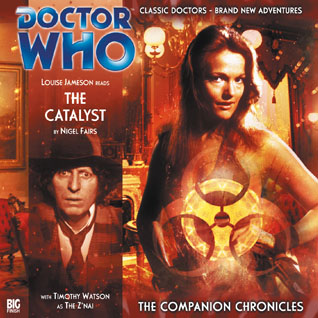|
| |
|
STORY PLACEMENT THE EVENTS OF THIS STORY TAKE PLACE BETWEEN THE NOVEL "DRIFT" AND THE TV STORY "HORROR OF
FANG ROCK." WRITTEN BY NIGEL FAIRS
DIRECTED BY NIGEL FAIRS
RECOMMENDED PURCHASE BIG FINISH 'COMPANION CHRONICLES' CD 2.4 (ISBN 1-84435-293-7) RELEASED IN JANUARY 2008.
BLURB
The pride of the Z'nai
matches that of Leela
of the Sevateem. Why
would the Doctor
imprison one in such
an unlikely place, and
what terrors will
be brought about by
letting it loose? |
|
|
The Catalyst JANUARY 2008 (2 EPISODES)
The second Companion Chronicle to be lifted from Tom Baker’s tumultuous tenure is every bit as evocative as the first. Whereas Jonathan Morris’ Romana story, The Beautiful People, drew out the sights and sounds of the declining Graham Williams era with characteristic aplomb, Nigel Fairs’ Leela adventure is every bit as successful in doing the same for the generally much better-respected Philip Hinchcliffe / Robert Holmes era of the series.
The Catalyst is utterly sodden with the gothic horror staples that were the backbone of the television serials that it is trying to recapture. Most prominently, Fairs’ script offers us the faded gentility of a stately home with a dark secret; a stately home with something quarant-ined in the trophy room….
However, unlike even some of the best mid-1970s Doctor Who adventures, The Catalyst has several layers to it, each of which presents its narrator with a fascinating dilemma. Most notably, Fairs’ story tackles the apparent contradiction in the Doctor’s character head-on – if he is a pacifist, then why does he always lead a trail of death in his wake? Now this has been done many times before and in many remarkable ways, but the brilliance of how Fairs tackles it here is that we are shown things through Leela’s candid, logical eyes. Listening to her trying to square the Doctor’s strident moral objection to killing (“No more Janis Thorns”) with the blood that is on his hands, be it vicariously or otherwise, is truly gripping stuff, and even a little sombre.
And for her part, Louise Jameson is a brilliant narrator. Armed with some terrific Leela dialogue, such as “the straight-backed man” (Lord Joshua Douglas) and “the corpse-faced man” (his butler), Jameson is able to recreate not only the sound but the spirit of the erst-while savage effortlessly. She also acquits herself well when it comes to voicing the rest of the characters, save for Baker’s Doctor, who – let’s face it – only Jon Culshaw can even come close to.
Fairs’ plot is also rather alluring. Timothy Watson’s Z’nai is perhaps a little too bland a foe for my tastes, and I really had to cringe at the convenience of their being clones, given that this is essentially a two-hand play! Nevertheless, it’s what the author does with them, as opp-osed to what they are, that makes The Catalyst so convincing. Indeed, Fairs’ execution is absolutely sublime; I particularly like how Lord Douglas is set up as a former companion to the third Doctor, and how – on the information presented to Leela - their parting of ways appeared to have been caused by the Doctor wanting to wipe out the Z’nai. Of course the truth is far less straightforward and far more agonising, and therein lays the drama.
More negatively, the lopsided lengths of the two episodes really knock the pacing for six. In my view, this one would have been far more effectual as four shorter episodes, as Fairs’ much snappier Blue Tooth was presented. There were certainly a couple more great cliff-hangers to be had here, though it’s only fair to say that the one that we do have is grossly macabre and utterly perfect. Spine-chilling, even.
The other thing that failed to impress me was the framing device used. Having an old Leela (Gallifrey has “gone” for her, interestingly) being interrogated by a Zednai works wonderfully in principle; Marc Platt even used the same device splendidly with Steven earlier in the run in Mother Russia. It all falls down though here when, Leela being Leela, she refuses to talk. As such the events of the story are presented as handily articulate memories of Leela’s, which for me felt more than a little incredible and a bit of a cop-out, really.
“In my death, whenever it comes... I will die neither afraid nor unenlightened for... I am, and always shall be, Leela of the Sevateem."
The ending of
the production is far from a cop-out, on the other hand, as the defiant
Leela finds herself facing the end of her artificially-prolonged life.
Never fear though: Fairs’ ending leaves the matter nice and open, should
the Companion Chronicles want to catch up with Leela again, and on
the strength of this outing, I certainly suspect that they will.
|
|
|
Copyright © E.G. Wolverson 2009
E.G. Wolverson has asserted his right under the Copyright, Designs and Patents Act, 1988 to be identified as the author of this work. |
|
|
This CD’s blurb states that the events of this story take place between the television serials The Talons of Weng-Chiang and Horror of Fang Rock. Within this gap, we have placed them after those depicted in the novels Eye of Heaven and Drift, which were released earlier.
The bookending scenes lead into those of the later audio book Empathy Games.
|
|
|
Unless otherwise stated, all images on this site are copyrighted to the BBC and are used solely for promotional purposes. ‘Doctor Who’ is copyright © by the BBC. No copyright infringement is intended. |
|

.jpg)
